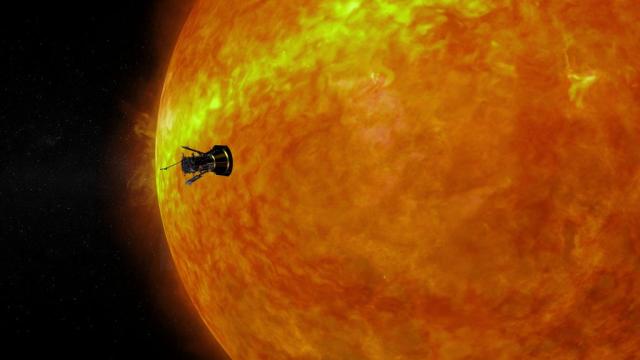The Sun, as you may know, is a giant blazing ball of nuclear fusion. It’s not the sort of thing you’d want to poke. But NASA scientists did just that, using the Parker Solar Probe to touch the Sun’s corona, making direct contact with the star’s plasma and atmosphere.
NASA’s been trying to do this for a while. Previously, the Parker Solar Probe set records for being the fastest spacecraft and the spacecraft to make the closest approach of the Sun. Now, the latter record has been outdone. The team’s results were published this week in Physical Review Letters.
“It is hard to overstate the significance of both the event and the observations made by Parker Solar Probe,” said Gary Zank, a co-investigator of the probe’s Solar Wind Electrons Alphas and Protons (SWEAP) Instrument, in an American Physical Society release. “For over 50 years, since the dawn of the space age, the heliospheric community has grappled with the unanswered problem of how the solar corona is heated to well over a million degrees to drive the solar wind.”
This ongoing mission to “touch the Sun” is a great way of better understanding heliophysics — how our star behaves. Since the Sun is the closest star to us, it’s also the only nearby proxy for understanding other stars in the universe. Mysteries around differences in temperature throughout the star and how the Sun’s corona produces the solar wind made NASA decide to launch a probe into the star itself. Of course, Parker had to be armed with major defences against the Sun’s extreme heat and radiation.
While in the Sun’s corona, the probe sampled particles and the strong magnetic fields that abound there. The magnetic fields on the Sun are probably responsible for its “campfires,” which are large arced flares that happen on the star’s surface. The corona is hundreds of times hotter than the Sun’s surface, and scientists hope that the probe’s — erm, probing — will help reveal why.
The probe’s sojourn into solar atmosphere actually happened in late April, when Parker made its eighth close approach of the star. Justin Kasper, an astrophysicist at the University of Michigan and the study’s lead author, told the AP that when the probe went into the Sun’s corona, it stayed there for about five hours, speeding through the piping hot plasma at 100 km per second. The probe also entered the corona during its ninth approach, which happened in August. According to a NASA release, that entry allowed the probe to image coronal streamers, which are structures of solar material that look like superheated threads.
From here on out, every close approach of the Sun will require the probe to travel through the corona, picking up more data on the way. Parker will continue to poke in and out of the Sun until its final orbit in 2025.
